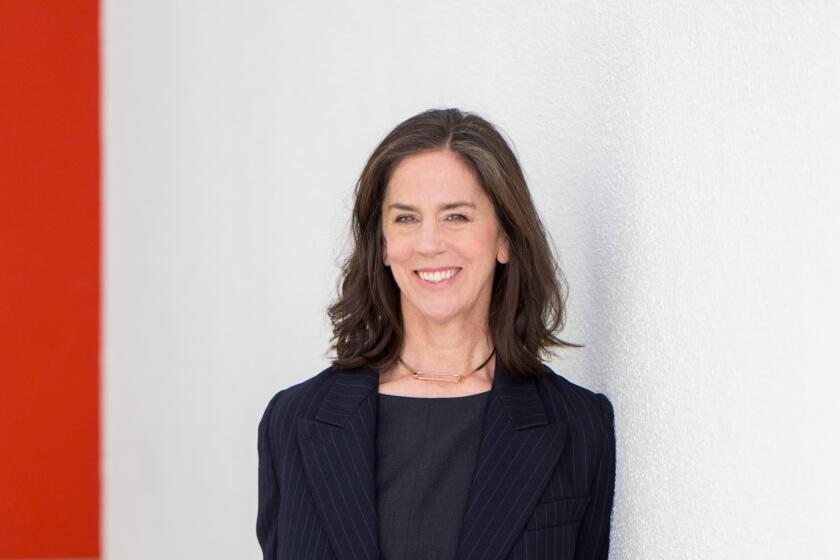Review: Flamin’ Hot Cheetos art packs a punch in MexiCali Biennial at the Cheech
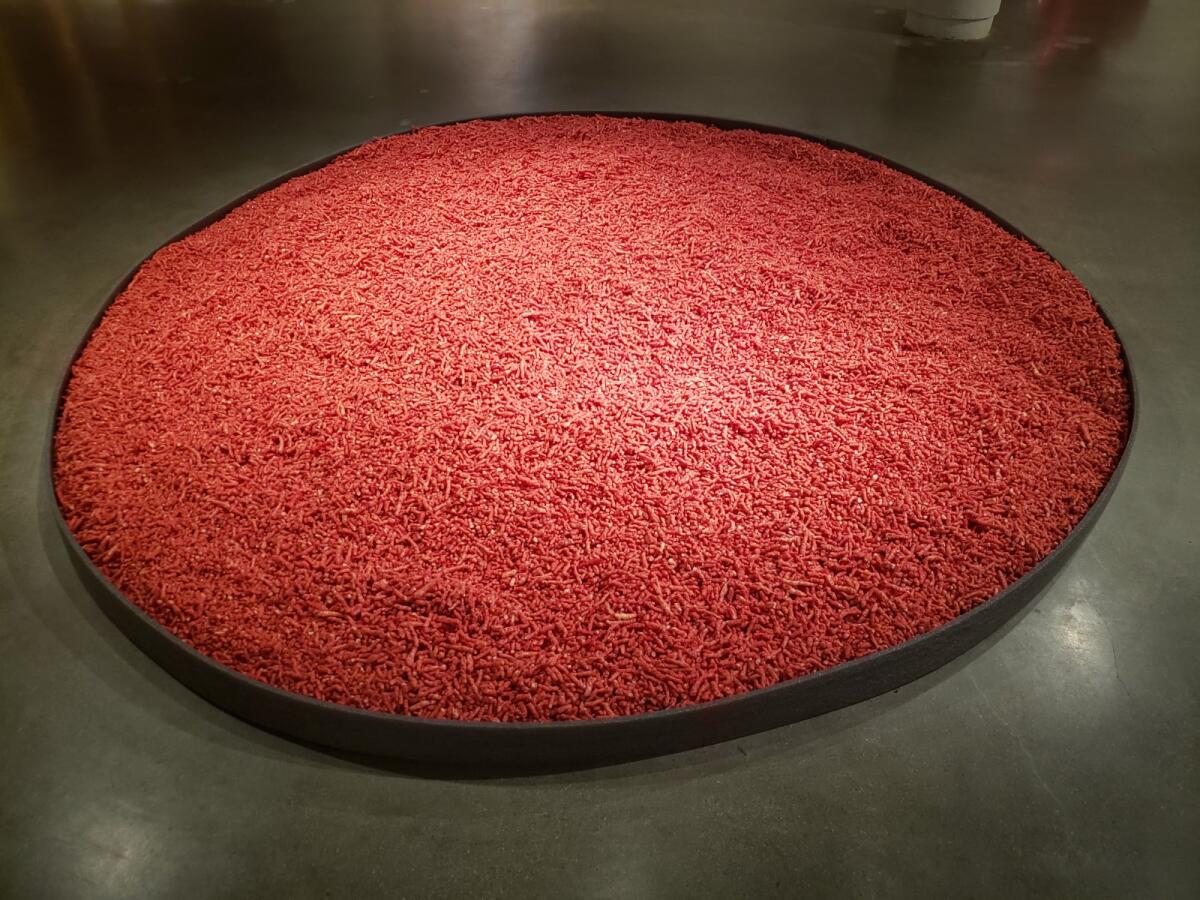
- Share via
Riverside — Gerald Clarke’s sculpture “Continuum Basket” lines up 668 crushed beer and soda cans in a spiral pattern, affixed to the shallow bowl of a TV satellite dish hanging at eye level on a wall. The low spiral creates a traditional Indigenous basketry form — Clarke, born in Hemet, is an enrolled member of the Cahuilla Band of Mission Indians — embedded into a high-tech parabolic antenna designed to transmit or receive information between near and far.
Like Marcel Duchamp’s “Rotorelief” sculptures that turn a spiraling graphic into a slyly hypnotic image to enthrall a mesmerized viewer, “Continuum Basket” is built from a device that streams spellbinding corporate television and internet into personal space. The crushed cans are product rubbish, evoking an injurious intake of virtually addictive quantities of alcohol and sugar. The subsistence labor of impoverished scavenging for littered aluminum cans collides with the number “668,” pointedly cited in the sculpture’s label. The figure conjures the IRS form number for a legal government seizure of property.
Clarke’s sculpture materially connects past and present. Disparate cultures link, cementing the bond through a mix of wit, worry and skepticism.
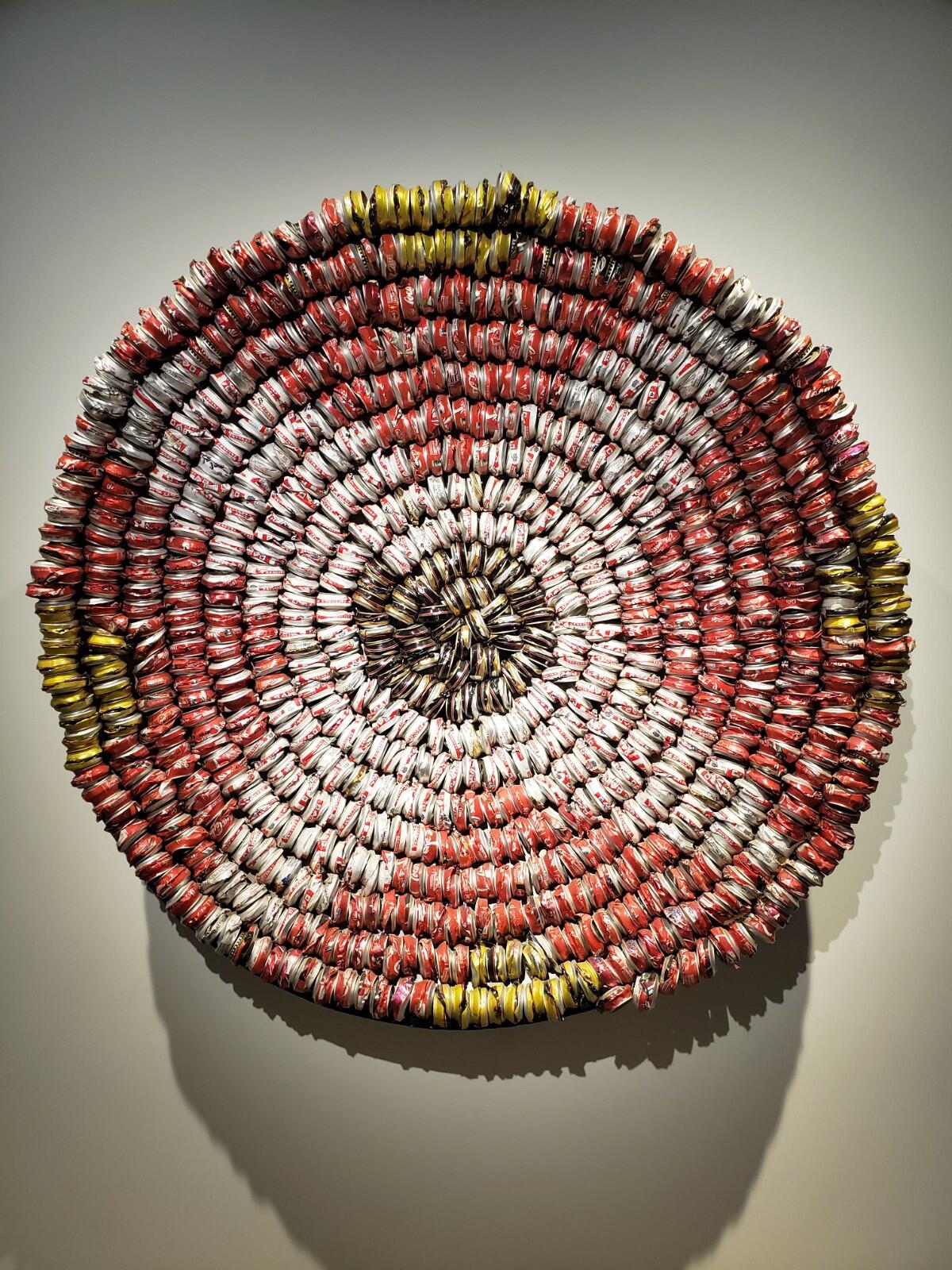
“Continuum Basket” holds a lot. It’s a virtual cornucopia within “Land of Milk and Honey,” a lively, engaging and sometimes sobering group exhibition at the Cheech Marin Center for Chicano Art and Culture of the Riverside Art Museum, through May 28.
Sculptures, installations and other works by more than 40 mostly American and Mexican artists are included. In Exodus, God led the Israelites out of slavery in Egypt to a land of milk and honey. The show’s theme is California agriculture, its biblical title framing the Golden State as part fertile and utopian paradise, part huckster marketing dystopia. Sometimes the milk is sweet, sometimes curdled; the honey fragrant or rancid.
Jazmín Urrea’s crispy, dark red “Pasarela de Chucherias” — a slang name that loosely translates as “a junk-food path” — is composed of a thick circle of Flamin’ Hot Cheetos laid out flat on the floor. Your encounter with this blazing sculptural form could be the exhibition’s equivalent of Moses coming across the miraculous burning bush. The crimson circle looks like an open wound or crusted scab, a sore blemish in the typically pristine space of an art museum gallery.
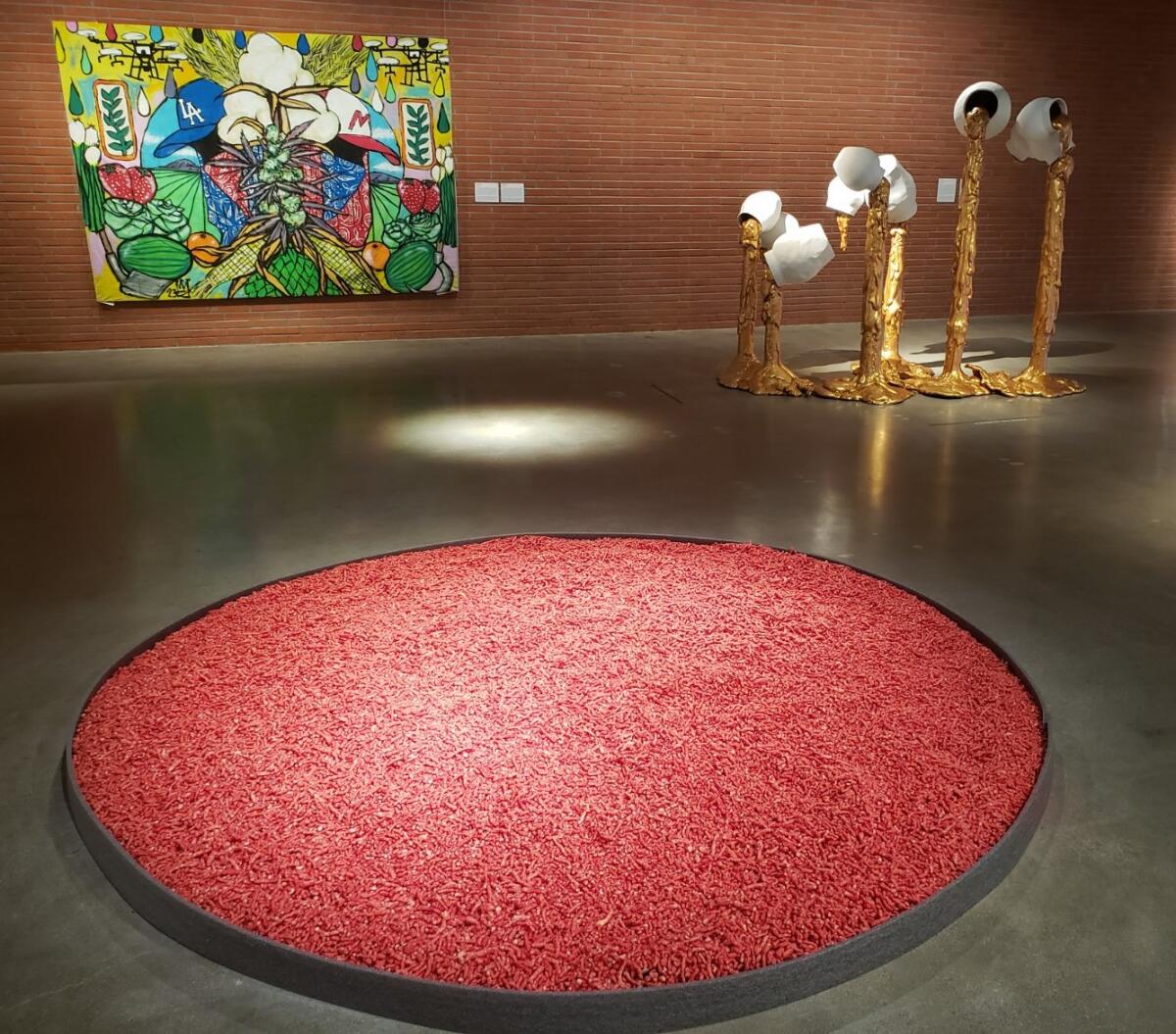
“Pasarela de Chucherias,” made of a hugely popular snack loaded with artificial colors and unpronounceable flavor enhancers (disodium guanylate, anyone?), makes a wicked nod in the direction of pristine Minimal and Conceptual sculptures like British artist Richard Long’s circles of stones gathered on hikes through the natural landscape, or German artist Wolfgang Laib’s gatherings of generative staples like flower pollen and rice. Urrea’s collecting excursions take place in neighborhoods like South L.A., where she lives and works, in “food deserts” marked by convenience stores rather than groceries or farmers markets.
The exhibition is divided into three loosely themed sections. At the center is “Food,” where Clarke, Urrea and other artists’ edibly defined paintings and sculptures are found.
Commentary: The Hammer just wrapped a major building project. Now, two of its curators are departing
The UCLA Hammer Museum, which opened a sizable building project in late March, has announced two major departures of senior staff, plus the arrival of a new curator.
Sustenance is flanked on one side by “Histories,” which tells personal narratives of California. They include stories both heavenly and hellish — and sometimes in between, as in Xavier Cázares Cortéz’s shelving loaded with personal collectibles, the structure crushing a red MAGA hat wedged underneath, like Dorothy’s house fallen on the Wicked Witch of the East.
On the other side is “Labor.” It glances off the cultivation and distribution of bounty, whether by Japanese, Filipino or Latin American immigrants who tilled the land, or in modernist architecture, like the Albert Lopez Jr. sculpture of a suspended enclosure based on Mondrian’s paintings, pierced with a grid-pattern of windows whose design replicates those in an Orange County jail.
Two other very different works, which nonetheless speak to one another across time and space, help frame the theme.
One, in “Histories,” is a group of 11 simple works on paper made in the 1950s and after in a Social Realist style. The muscular charcoal drawings and darkly inked linocuts by Domingo Ulloa (1919-1997), who is sometimes called the father of Chicano art, record genre scenes of post-World War II braceros, Mexican guest workers toiling on West Coast farms. Ulloa, born in Pomona and trained in Mexico City, took the socially oriented printmaking of the revolutionary Taller de Gráfica Popular to heart.
For good and for ill, those milk and honey farms would barely exist without the water being channeled in through herculean industrial effort from natural sources like the Colorado River. At the other end of the show, in the section devoted to “Labor,” a gorgeous, nearly half-hour recent film projection by Camilo Ontiveros and Javier Tapia, produced with the aid of high-tech drones, follows the glistening water and its impact from high in the cloud-swept Rocky Mountains to the desiccated edge of Arizona’s Sonoran Desert and Mexico’s Sea of Cortez.
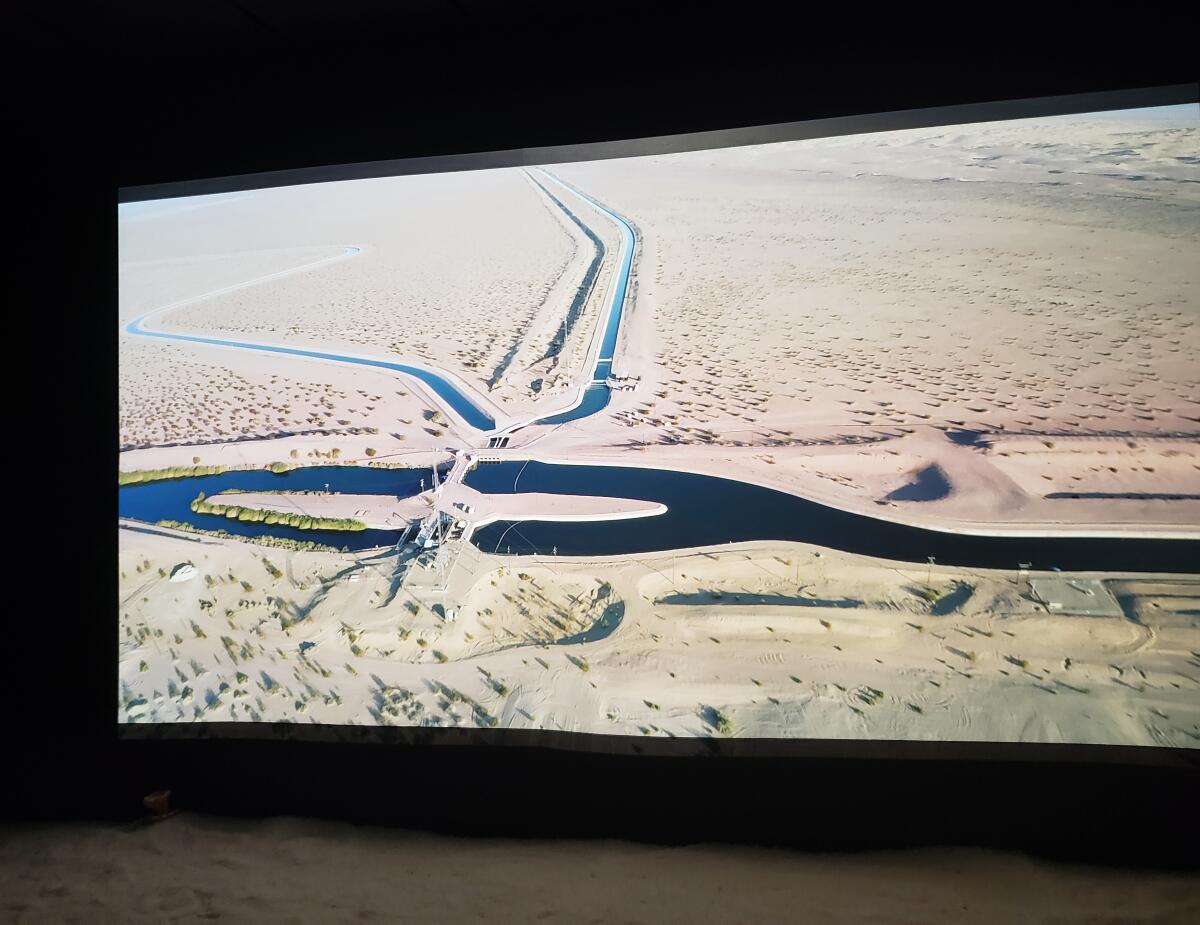
The film is a collaboration with director Nicolás García, photographer Ruben Diaz, musician Steve Rioux and the two artists. Shown in a darkened, low-ceilinged room, the floor strewn with a layer of salt and sand that crunches loudly underfoot, the ethereally beautiful, even fragile poetic imagery in “Liquid Light” flows between luminous aerial panoramas and close-up details as intimate as tiny dead bugs scattered on parched earth.
There’s much more. The exhibition is the fifth installment of the MexiCali Biennial, a series of art projects related to the two historic Californias — Alta y Baja — and conceived by artists Ed Gomez and Luis G. Hernández. (Gomez is co-curator of “Land of Milk and Honey” with April Lillard-Gomez and Pomona College art historian Rosalía Romero.) A kind of “anti-biennial,” it was born in the shadow of the commercially oriented global proliferation of biennial exhibitions early in the 21st century.
To understand its smartly renegade spirit, which is charted here in a number of documentary displays in a side gallery, all you need to know is that the first biennial was held in 2006 and the second in 2009 — three years later, not two. The global financial crisis of the prior year may have been a factor, but the show has also been mounted in the off years of 2013 and 2018. Tossing the demands of a biennial calendar just might be a wry nod to the playful, self-deprecating joke about being “on Mexican time.”
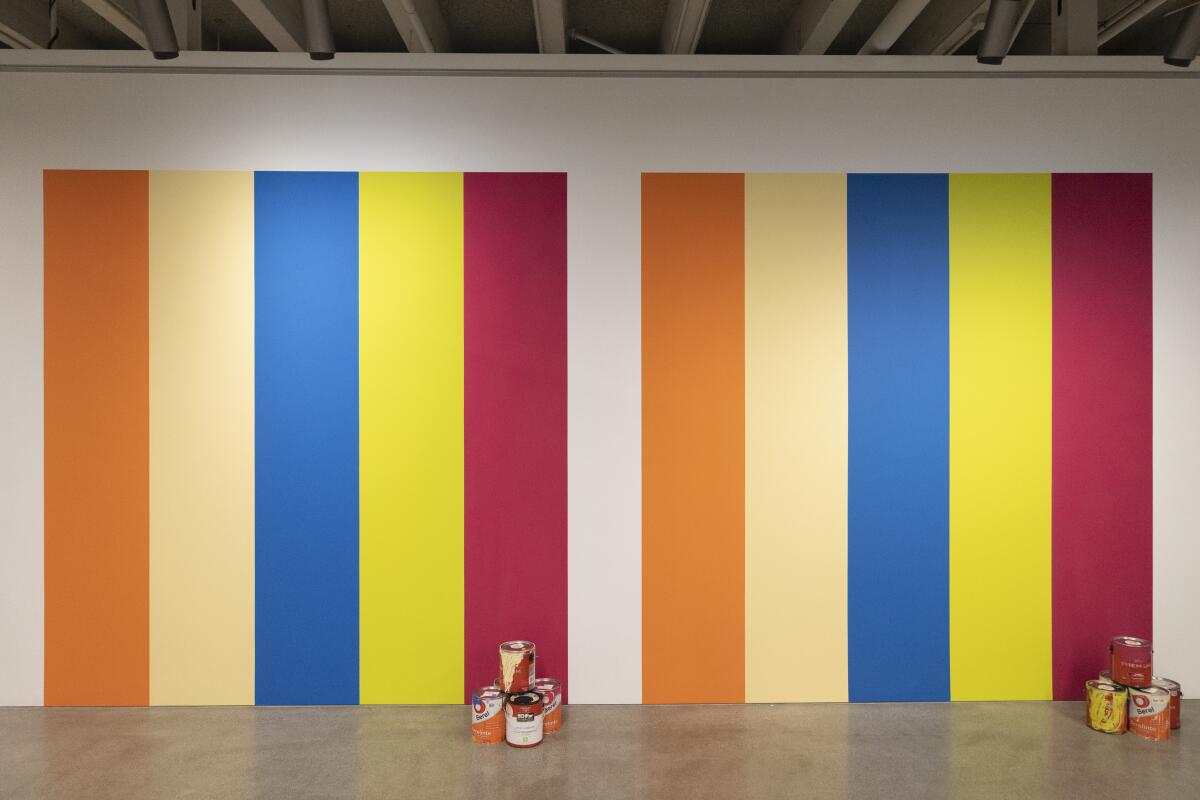
In addition to the documents, a wonderful 2006 Hernández mural, reinstalled here, articulates the series’ founding temperament. Two sets of five wide, flat, unmodulated stripes of different colors — orange, cream, blue, yellow and red — are repeated on the wall, with a white space separating them. To make the mural, Hernández went to each side of the Mexico-California border and bought five cans of paint in identical hues from two Home Depot stores — a well-known location for hiring available day-laborers. Then he went to work himself, painting the museum wall.
A viewer goes back and forth in front of the mural, checking out one “skin” of colors against the other, searching out similarities and differences between them. Now you see them, now you don’t.
The famous Mexican and Chicano mural traditions, from Diego Rivera on, are almost exclusively figurative, given their educational goal as community platforms recording cultural history and advocating for social progress. But this one is a purely geometric abstraction, complete with Minimal and Conceptual art underpinnings. The social dynamics of mural traditions well up in a wholly contemporary way, their profound legacy given a thrilling spin.
The tables get turned. Who could ask for more?
'Land of Milk and Honey'
Where: The Cheech Marin Center at the Riverside Art Museum, 3581 Mission Inn Ave., Riverside
When: Through May 28. 10 a.m.–5 p.m. Tuesday-Sunday. Closed Mondays
Info: (951) 684-7111, www.riversideartmuseum.org
More to Read
The biggest entertainment stories
Get our big stories about Hollywood, film, television, music, arts, culture and more right in your inbox as soon as they publish.
You may occasionally receive promotional content from the Los Angeles Times.
